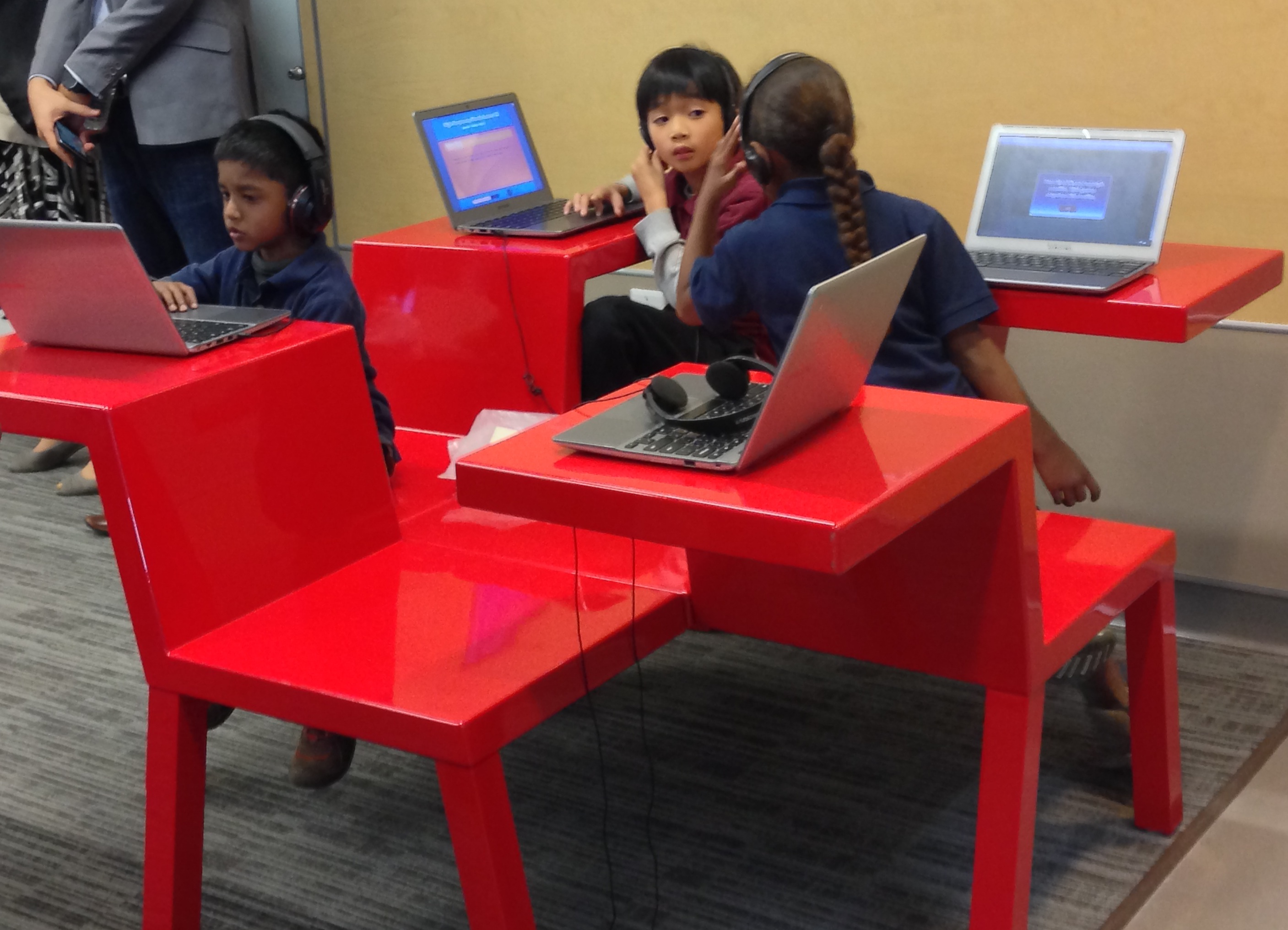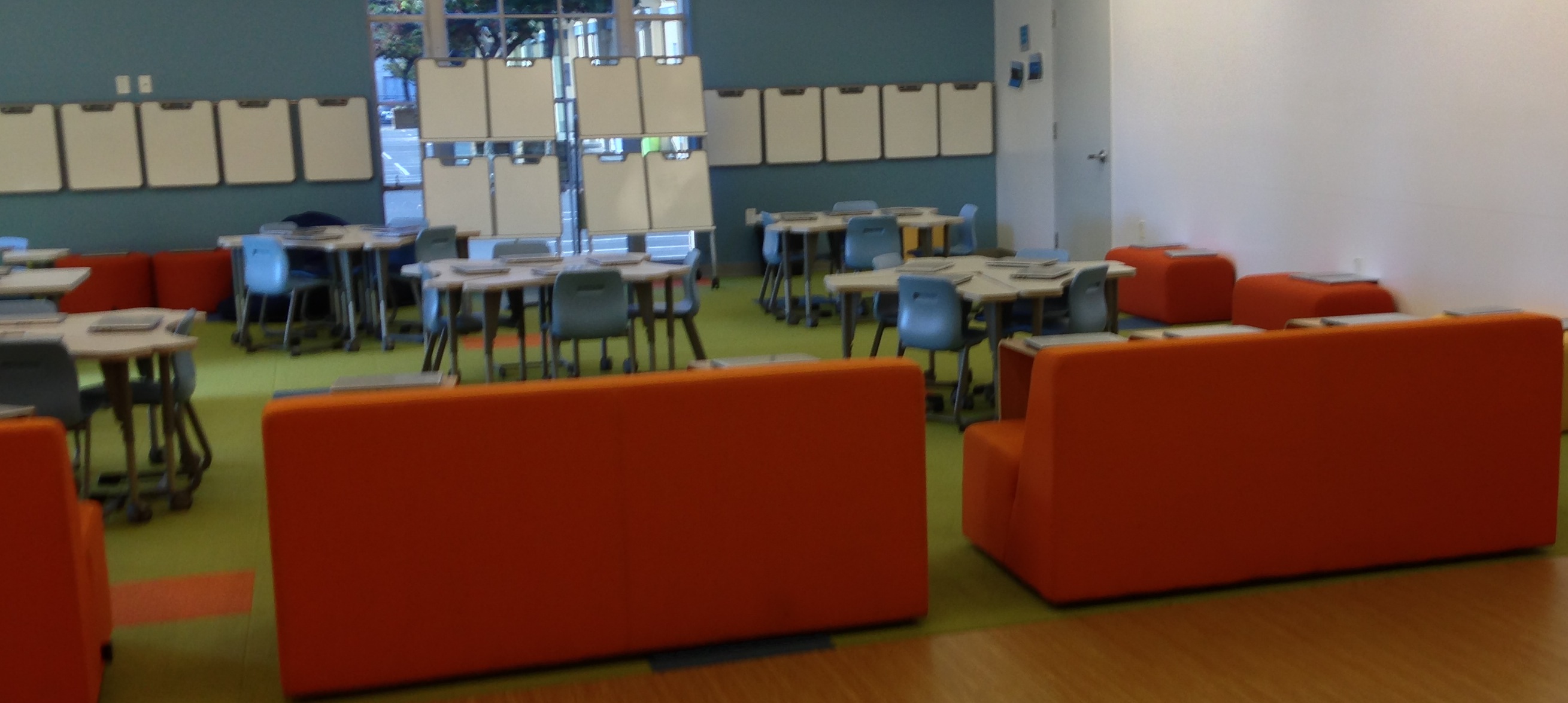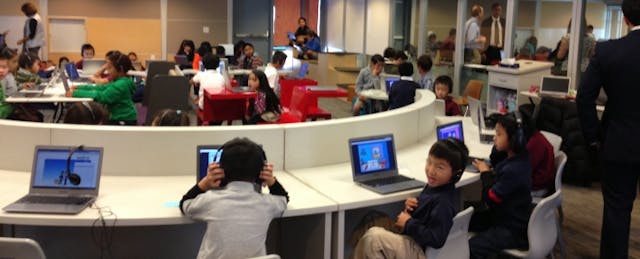Step inside Milpitas High School, and you will see Chromebooks on every desk, students blogging in class, and small groups testing out wind turbines to power model homes. Head down the street to Weller Elementary School, and you’ll start to see similarities: Laptops are in every classroom, QR codes with secret messages are posted in the halls, and 130 students at a time rotate through a newly remodeled learning lab where they spend 30 minutes, twice a day, using adaptive digital curriculum. Education is blended. And in many cases, students are charting their learning paths.
This isn’t another Silicon Valley charter school, and it isn’t an elite district in a wealthy suburb. Milpitas is a public school district at the very edge of the San Francisco Bay Area, home to 10,000 students, fully half of whom are immigrants. And yet in less than two years, this district has become a standout example of transformation in public schools, literally a stopping point when international visitors come to learn about how Silicon Valley teaches its youth. Most important: it got there thanks to the plans created by its teachers.
“Districts usually take years to plan and produce a binder that sits on a shelf. But binders do not change the system,” says district Superintendent Cary Matsuoka. So two years ago, Matsuoka asked his district teachers and principals one simple question: “If you could design a school what would it look like?”
After a three-month design process in the spring of 2012, Milpitas teachers were ready to pitch their new models to Matsuoka, his executive cabinet and the teachers’ union. The result: two-thirds of elementary school classrooms are now implementing blended learning, 3,500 Chromebooks have been dispersed across the district, and data points are being collected on 7,000 students every day with iReady software. Here’s how it happened.
Making Innovation Possible
In March of 2012, Matsuoka was inspired by work from the emerging field of “design thinking,” where prototyping was fast, designers learned from mistakes, and it was okay to take risks. He wanted to bring design thinking into the district to inspire the district’s school redesign process. And so he kicked off Milpitas’ first design challenge.
Matsuoka gave each site parameters to create their school model. The models had to integrate technology, use data to inform instruction, be student-centered and flexibly use space, time, and student grouping. Some plans were patterned after Rocketship, a charter network with five schools 10 miles south in San Jose with deep experience in experiment with technology--including teaching 90 student in one space at a time. Other schools, such as Marshall Pomeroy Elementary School run by Principal Sheila Murphy Brewer, instead focused on addressing the diverse needs of a school where fully half of the 506 students are English language learners. “Blended learning came out of the necessity of reaching all abilities,” she says.
After three months, teachers and principals presented their plans to school district’s central office staff, the school board, and union leadership. Proposals to transform numerous classrooms at Randall Elementary and Weller Elementary into blended learning environments won approval: Both schools planned to incorporate learning lab rotations, where one-third of the students would rotate through a learning lab for an hour each day, reducing class sizes at those times.
To support the redesign, Milpitas secured a waiver from the California Department of Education to run a learning lab for 130 students with only one certified teacher and a few coaches. (Current California Ed Code prescribes a maximum student-teacher ratio of 33:1.) Milpitas also boldly proposed a $95 million bond to pay for remodeling the school spaces, technology integration, and the technology itself. The bond passed by 64% of the voters in June 2012.
Construction of the remodeled learning labs at Randall and Weller was finished in time for the 2013-14 school year; 3,500 Chromebooks were rolled out across the district. Burnett Elementary School wound up accelerating its plans and implemented similar changes in a number of its classrooms this school year as well as creating its own learning lab. By November 2013, blended learning had spread through many classrooms in the district’s nine elementary schools: two-thirds of the classrooms offered some form of classroom rotation, which Matsuoka describes as “a familiar way to do this, harkening back to rotations used in elementary schools for years.”
This gentle familiarity seems to be the way to go. Matsuoka tells schools in his district not yet implementing blended learning: “You don’t have to do this. You do this when you’re ready.” Matsuoka isn’t rushing anyone. “We give them time and space. Peer pressure is going to solve the problem… their peers will be the ones asking them to get on board.”
A Peek Inside
On a tour throughout the district, teachers seemed to be embracing blended learning in all their classrooms. Some classes use a one-to-one model, each student equipped with a Chromebook. Others rely on in-class rotations with some students on computers, some doing independent or group work, and others getting direct instruction from a teacher. Each teacher is finding his or her own way of managing time, space, and groupings of students.
Classrooms are using a variety of different tools and software programs but iReady, an adaptive reading and math digital curriculum program, is a constant for students in grades K-8. Matsuoka says that using iReady means that district classrooms generate some consistent data. Other tools used widely in classrooms include Khan Academy, Edmodo, Newsela and NoRedInk.
Weller Elementary School
Weller Elementary is equipped with a brand new 130 student learning lab with 130 computers, a set of Chromebooks in every classroom. Students rotate into the lab twice a day for 35-minutes sessions. The lab looks more like a Silicon Valley coffee shop than a school computer lab with brightly colored chairs and couches, students from different grade levels sitting on elevated steps with headphones on and computers in their laps. One certified teacher and three coaches are on hand to support students as they study.

For students, mornings in the lab focus on English language arts work on iReady; afternoons are devoted to math. While students work quietly responding to prompts from their computer, the coaches and teacher walk around the room answering questions, resolving technical difficulties.
Within classrooms, teachers use a rotational model: the 34 students in a sixth grade math class are split into four groups. One group takes notes, others watch Khan Academy videos, while others work on group projects. The teacher coaches those in another group.
Burnett Elementary School
Burnett Elementary School’s learning lab relies on a huge garage-style door that slides up to divide the space into two rooms--and to harkening back to the days when Silicon Valley startups began in garages. The space is meant to be used for mixed purposes, offering soundproof areas for students to work on projects, while others can quietly work on the computer or receive direct instruction in small groups.

In classrooms, students are also doing classroom rotations. In the fourth grade math class, students rotate every twenty minutes between Khan Academy, group work on Common Core performance tasks, creating their own videos on Educreations, and peer coaching. Students put their name on a ‘peer coaching’ board, to volunteer to help other struggling students. Their teacher, Allison Elizondo, stands by to help struggling students and ensure that all goes smoothly.
“When you give kids freedom, they just go for it,” says Elizondo. “I don’t see myself as a traditional teacher, I see myself as a coach.”

Milpitas High School:
In this 3,000 student campus, it’s rare to see lectures. Instead, teachers are using the one-to-one computer learning environment to harness technology as a creative tool.
Students create their own blogs in Mandarin class to track what they learn in each lesson. They also use Blendspace to create their own quizzes for practice. In a 10th grade social studies class, students partner up around Chromebooks to answer test questions together that feed a live spreadsheet projected in the front of the class. The teacher reviews the spreadsheet in real time, addressing mistakes with the class as they arise.
Principal Ken Schlaff explains that 10th graders spend three hours a day in a project-based learning class, where they explore cross content in chemistry, language, and world history. Three teachers, experts in each content area, teach the class collaboratively, all sharing a common prep time. Teams of students are producing their own books exploring chemistry and conflict.
Results To Come
Matsuoka will be the first to say that he’s eager to see the data on how students are learning from of his district’s experimentation with blended learning. As the blended models were implemented only in the autumn of 2013, Matsuoka plans to rely on iReady assessments for benchmark data, along with Northwest Education Association for deeper program assessment. So far, the district has amassed more than 200,000 data points; it plans to have the results ready for the Milpitas school board in June 2014.
Another key indicator: teacher sentiment. School board member Danny Lau says that when the district surveyed staff in the Spring of 2013, more than 80% said they wanted to continue with the new direction largely because kids weren’t bored any longer in class.
That’s got Matsuoka’s attention. And although he is proud that Milpitas is a leader, he’s eager to see blended learning take root in more districts. “We need more districts that are examples and we need evidence to show that it works, the difference it makes.”


